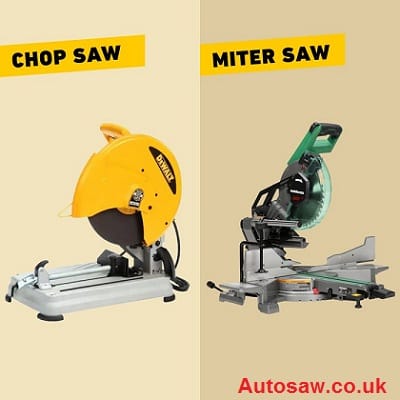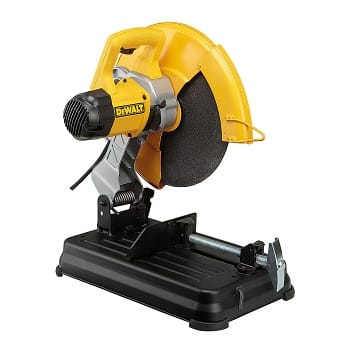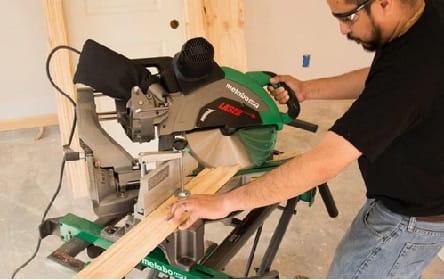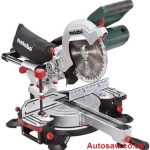As an Amazon Associate, I earn from qualifying purchases.

When it comes to cutting wood, it can be confusing to choose the right saw for your project. While there are many options, two top contenders are the mitre saw and the chop saw, sometimes known as a metal-cutting saw. With similar features, it can be difficult to decide between the two. In this article, we’ll take a closer look at both saws, make a comparison of the two, and help you determine which one will be best for your woodworking projects.
Contents
Mitre Saw Vs Chop Saw
There are two main types of saws that are used for cutting wood: the mitre saw and the chop saw. Both saws have their own unique benefits that make them ideal for different applications. Here is a brief overview of each saw to help you decide which one is right for your next project.
The mitre saw is a type of saw that is used for making precise cuts at a variety of angles. This saw is ideal for projects that require accurate cuts, such as trim work or molding. The chop saw, on the other hand, is a saw that is designed for making quick, rough cuts. This saw is ideal for projects that require a lot of material to be removed quickly, such as demolition work.
What Is The Difference Between A Chop Saw And A Mitre Saw?

A chop saw is a type of saw that uses a cutting action to chop through materials, while a mitre saw is a type of saw that uses a back and forth motion to cut through materials.
How Do You Know Which One o Use For Your Project?
The two main types of saws used for cutting wood are the mitre saw and the chop saw. Both saws have their own advantages and disadvantages, so it is important to know which one is the best for your project.
The mitre saw is a versatile saw that can be used for a variety of projects. It can be used to cut straight or angled cuts, and it can also be used to make bevel cuts. The mitre saw is also easier to use than the chop saw, making it a good choice for beginners.
The chop saw is a powerful saw that is mainly used for making straight cuts. It is not as versatile as the mitre saw, but it can make clean, precise cuts. The chop saw is also a good choice for projects that require a lot of power, such as cutting through thick pieces of wood.
What Are The Benefits Of Each Saw?
There are many benefits to using a saw, and the type of saw you use will depend on the project you are working on. A mitre saw is great for making precise cuts, and is often used for trim work or projects that require precise angles. A chop saw is more powerful and can make deeper cuts, making it ideal for projects that require more material to be removed.
Which Saw Is Better For Making Precise Cuts?
There are a few different types of saws that can be used to make precise cuts, but in general, a mitre saw or chop saw is going to be the best option. These saws are designed to make clean, straight cuts, and they can be adjusted to make very precise cuts. If you need to make a lot of precise cuts, or if you need to cut very thick material, then a mitre saw is going to be the better option. However, if you only need to make a few precise cuts, or if you’re working with thinner material, then a chop saw may be a better choice.
How Do You Use A Chop Saw?

A chop saw is a handheld power tool that is used to make quick, clean cuts in wood. It is similar to a circular saw, but has a blade that is fixed in place, making it more precise.
To use a chop saw, first make sure that the blade is sharp and in good condition. Then, position the wood so that it is flush with the edge of the saw table. Next, turn on the saw and slowly guide it through the wood, keeping the blade perpendicular to the surface. Finally, turn off the saw and allow the blade to cool before removing the wood.
How Do You Use A Mitre Saw?

Assuming you are referring to a handheld mitre saw, they are generally used for making quick, precise cuts in wood. They are especially useful for cutting mitres (angles cut at 45 degrees) and for trim work. To use one, first make sure the blade is properly secured and the saw is unplugged. Next, set the saw to the desired angle and position the wood against the blade. When you are ready, plug in the saw and slowly guide it through the wood. Be sure to follow the line you have marked out and to keep your hands clear of the blade. When you are finished, unplug the saw and allow the blade to cool before cleaning up.
Conclusion
Choosing between a mitre saw and a chop saw ultimately depends on the type of cuts you need to make for your woodworking projects. If you need to make precise angled cuts, a mitre saw is the way to go. If you need to make straight cuts on large workpieces or materials like metal, a chop saw is the better option.
Remember to prioritize safety when using power tools like a mitre saw or chop saw and always use the appropriate blade for the materials you are cutting. With the right saw and techniques, you can make beautiful and functional woodworking projects that you’ll be proud to display!





